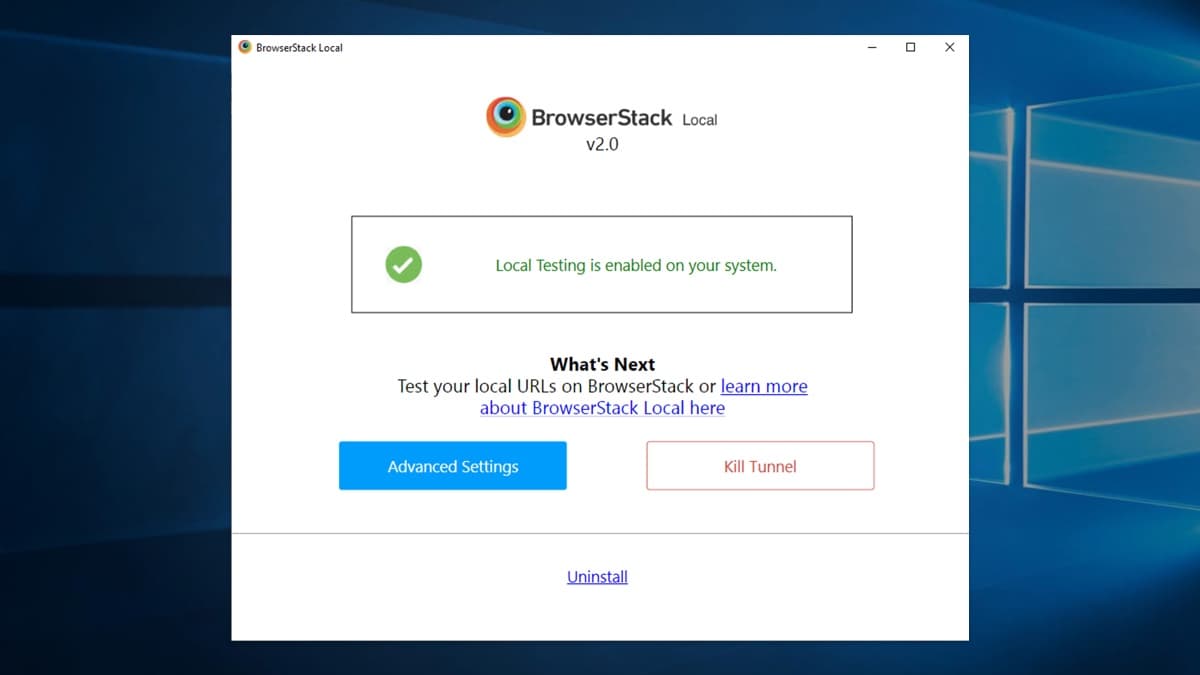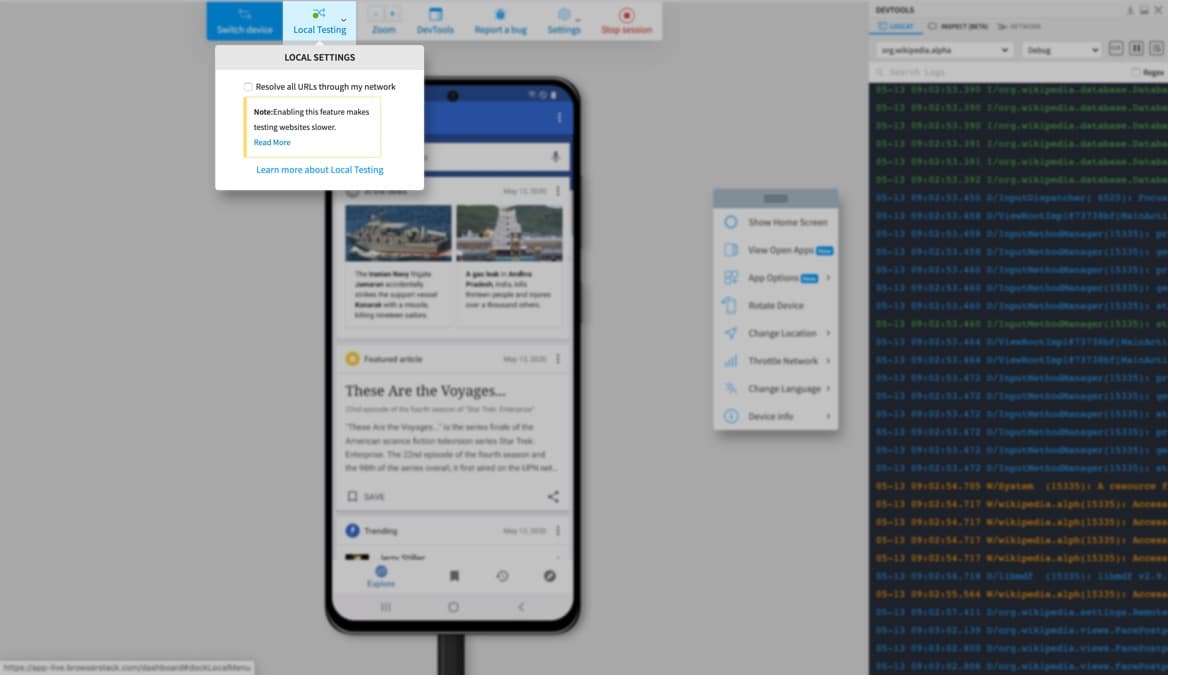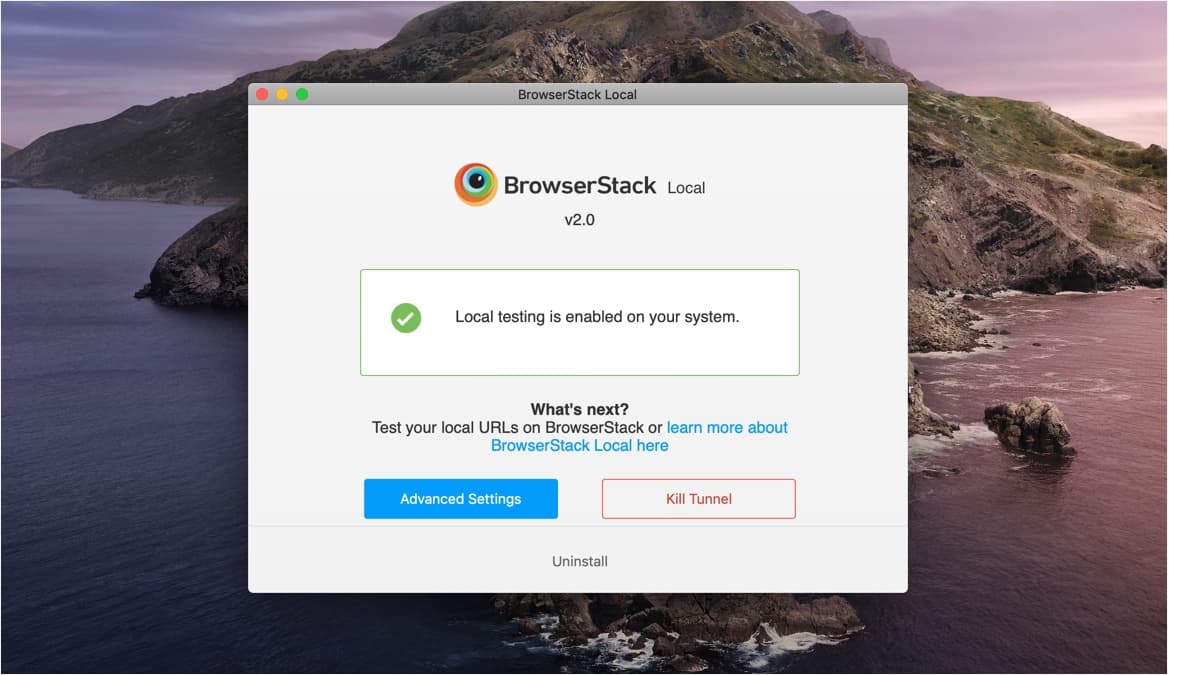Enable Local Testing with App Live
This guide shows you how to set up Local Testing with BrowserStack App Live.
Introduction
If you’re using Chrome or Firefox to visit BrowserStack App Live for the first time, you will see a prompt. It will guide you through the basic Local Testing setup for your environment.
To verify whether you’ve already enabled Local Testing on App Live sessions, start a session and look for the Local Testing icon in the overhead toolbar.

If there is no Local Testing icon, you’ve already enabled it. If there is a Local Testing icon (with a red indicator) you can set up Local Testing for your App Live sessions by following the steps below.
Enable Local Testing
Select the OS and browser that you are using to access BrowserStack App Live. Then, follow the setup instructions.
Search for the BrowserStack Local app on your machine. If you have the app installed, Local Testing will be enabled for your App Live sessions. There is no additional setup required.
If you don’t have BrowserStack Local app on your machine, download the BrowserstackLocal app (for Windows). Start the app and you’ll see the following screen:

This enables Local Testing. Start an App Live session and look for a green indicator on the Local Testing icon in the toolbar dock.
To resolve all requests to local URLs via your machine, click on the Local Testing icon and check Resolve all URLs through my network option.
For example, if there is a URL like abc.com which is restricted to your
network or you have /etc/hosts entry for abc.com mapping to localhost or an
internal server/environment, this option will resolve all abc.com requests
from remote browser/mobile device via your machine.

First, Download the BrowserStack Local binary for Windows.
Unzip the file to a folder/directory on your machine, and open command-line interface and navigate to the folder containing the Local binary. Run the Local binary using the following command:
BrowserStackLocal.exe --key YOUR_ACCESS_KEY
Now start an App Live session. You’ll notice that the Local Testing icon in the overhead toolbar has disappeared. This indicates that Local Testing for App Live is now enabled.
To resolve all requests to local URLs via your machine, establish the Local
Testing connection with a --force-local flag, as follows:
./BrowserStackLocal --key YOUR_ACCESS_KEY --force-local
For example, if there is a URL like abc.com which is restricted to your
network or you have /etc/hosts entry for abc.com mapping to localhost or an
internal server/environment, this option will resolve all abc.com requests
from remote browser/mobile device via your machine.
Search for the BrowserStack Local app on your machine. If you have the app installed, Local Testing will be enabled for your App Live sessions. There is no additional setup required.
If you don’t have BrowserStack Local app on your machine, download the BrowserstackLocal app (for macOS / OS X). Click on the BrowserstackLocal.pkg and install it. Start the app and you’ll see the BrowserStack Local icon in your menu bar at the top of the screen like this:

This enables Local Testing. Start an App Live session and look for a green indicator on the Local Testing icon in the toolbar dock.
To resolve all requests to local URLs via your machine, click on the Local Testing icon and check Resolve all URLs through my network option.
For example, if there is a URL like abc.com which is restricted to your
network or you have /etc/hosts entry for abc.com mapping to localhost or an
internal server/environment, this option will resolve all abc.com requests
from remote browser/mobile device via your machine.

First, Download the BrowserStack Local binary for macOS / OS X.
Unzip the file to a folder/directory on your machine, and open command-line interface and navigate to the folder containing the Local binary. Run the Local binary using the following command:
./BrowserStackLocal --key YOUR_ACCESS_KEY
Now start an App Live session. You’ll notice that the Local Testing icon in the overhead toolbar has disappeared. This indicates that Local Testing for App Live is now enabled.
To resolve all requests to local URLs via your machine, establish the Local
Testing connection with a --force-local flag, as follows:
./BrowserStackLocal --key YOUR_ACCESS_KEY --force-local
For example, if there is a URL like abc.com which is restricted to your
network or you have /etc/hosts entry for abc.com mapping to localhost or an
internal server/environment, this option will resolve all abc.com requests
from remote browser/mobile device via your machine.
First, Download the appropriate BrowserStack Local binary for your system: Linux 32-bit | Linux 64-bit
Unzip the file to a folder/directory on your machine, and open command-line interface and navigate to the folder containing the Local binary. Run the Local binary using the following command:
./BrowserStackLocal --key YOUR_ACCESS_KEY
Now start an App Live session. You’ll notice that the Local Testing icon in the overhead toolbar has disappeared. This indicates that Local Testing for App Live is now enabled.
To resolve all requests to local URLs via your machine, establish the Local
Testing connection with a --force-local flag, as follows:
./BrowserStackLocal --key YOUR_ACCESS_KEY --force-local
For example, if there is a URL like abc.com which is restricted to your
network or you have /etc/hosts entry for abc.com mapping to localhost or an
internal server/environment, this option will resolve all abc.com requests
from remote browser/mobile device via your machine.
Disconnecting Local Testing
The Local Testing connection is persistent. Essentially, your machine and BrowserStack Cloud remain connected unless:
- You explicitly end the connection (for example, when using the binary)
- You close the browser window
- You sign out of your BrowserStack account.
Even if you accidentally close the browser tab, you can resume Local Testing on re-opening it.
What isn’t supported?
Currently, Local Testing with App Live does not support proxies with advanced authentication like Windows, Digest, etc. and NTLM authentication for hosts. We are working on adding support for these soon.
Next Steps
- Learn how to test your apps using Local Testing
- Learn how to test apps from behind one (or more) proxies
- Learn how to test apps from behind a firewall or VPN
- Learn more about what isn’t supported
We're sorry to hear that. Please share your feedback so we can do better
Contact our Support team for immediate help while we work on improving our docs.
We're continuously improving our docs. We'd love to know what you liked
We're sorry to hear that. Please share your feedback so we can do better
Contact our Support team for immediate help while we work on improving our docs.
We're continuously improving our docs. We'd love to know what you liked
Thank you for your valuable feedback!
